Copper Island is a local name for the northern part of the Keweenaw Peninsula in northern Michigan, United States.
Copper Island may also refer to:

Aleuts are the Indigenous people of the Aleutian Islands, which are located between the North Pacific Ocean and the Bering Sea. Both the Aleuts and the islands are politically divided between the US state of Alaska and the Russian administrative division of Kamchatka Krai. This group is also known as the Unangax̂ in Unangam Tunuu, the Aleut language. There are 13 federally recognized Aleut tribes in the Aleut Region of Alaska. In 2000, Aleuts in Russia were recognized by government decree as a small-numbered Indigenous people.

Eskimo is an exonym that refers to two closely related Indigenous peoples: Inuit and the Yupik of eastern Siberia and Alaska. A related third group, the Aleut, who inhabit the Aleutian Islands, are generally excluded from the definition of Eskimo. The three groups share a relatively recent common ancestor, and speak related languages belonging to the family of Eskaleut languages.

The Upper Peninsulaof Michigan—also known as Upper Michigan or colloquially the U.P.—is the northern and more elevated of the two major landmasses that make up the U.S. state of Michigan; it is separated from the Lower Peninsula by the Straits of Mackinac. It is bounded primarily by Lake Superior to the north, separated from the Canadian province of Ontario at the east end by the St. Marys River, and flanked by Lake Huron and Lake Michigan along much of its south. Although the peninsula extends as a geographic feature into the state of Wisconsin, the state boundary follows the Montreal and Menominee rivers and a line connecting them.

Copper Island is a local name given to the northern part of the Keweenaw Peninsula, separated from the rest of the Keweenaw Peninsula by Portage Lake and the Keweenaw Waterway.
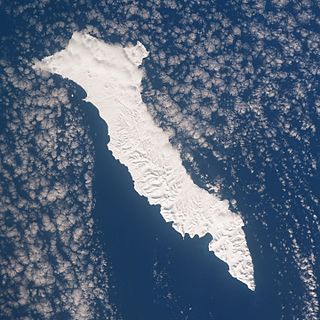
Bering Island is located off the Kamchatka Peninsula in the Bering Sea.

The Eskaleut, Eskimo–Aleut or Inuit–Yupik–Unangan languages are a language family native to the northern portions of the North American continent, and a small part of northeastern Asia. Languages in the family are indigenous to parts of what are now the United States (Alaska); Canada including Nunavut, Northwest Territories, northern Quebec (Nunavik), and northern Labrador (Nunatsiavut); Greenland; and the Russian Far East. The language family is also known as Eskaleutian, Eskaleutic or Inuit–Yupik–Unangan.
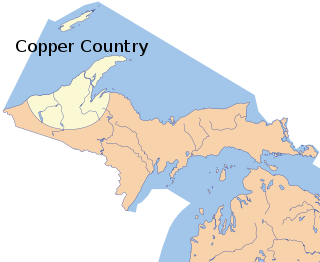
The Copper Country is an area in the Upper Peninsula of Michigan in the United States, including Keweenaw County, Michigan, Houghton, Baraga and Ontonagon counties as well as part of Marquette County. The area is so named as copper mining was prevalent there from 1845 until the late 1960s, with one mine continuing through 1995. In its heyday in the latter half of the 19th century and the early 20th century, the area was the world's greatest producer of copper.
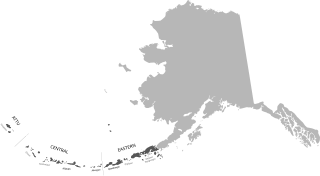
Aleut or Unangam Tunuu is the language spoken by the Aleut living in the Aleutian Islands, Pribilof Islands, Commander Islands, and the Alaska Peninsula. Aleut is the sole language in the Aleut branch of the Eskimo–Aleut language family. The Aleut language consists of three dialects, including Unalaska, Atka/Atkan, and Attu/Attuan.

In the classification of the archaeological cultures of North America, the Archaic period in North America, taken to last from around 8000 to 1000 BC in the sequence of North American pre-Columbian cultural stages, is a period defined by the archaic stage of cultural development. The Archaic stage is characterized by subsistence economies supported through the exploitation of nuts, seeds, and shellfish. As its ending is defined by the adoption of sedentary farming, this date can vary significantly across the Americas.
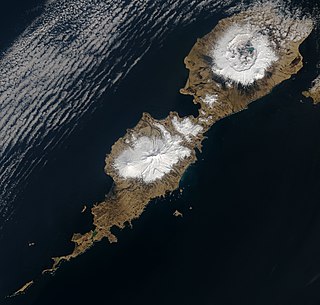
Umnak is one of the Fox Islands of the Aleutian Islands. With 686.01 square miles (1,776.76 km2) of land area, it is the third largest island in the Aleutian archipelago and the 19th largest island in the United States. The island is home to a large volcanic caldera on Mount Okmok and the only field of geysers in Alaska. It is separated from Unalaska Island by Umnak Pass. In 2000, Umnak was permanently inhabited by only 39 people and by 2010, around 18, placing the settlement of Nikolski in difficulty and its school was closed.

Medny Island, also spelled Mednyy or Mednyi, sometimes called Copper Island in English, is the smaller of the two main islands in the Commander Islands in the North Pacific Ocean, east of Kamchatka, Russia. These islands belong to the Kamchatka Krai of the Russian Federation.
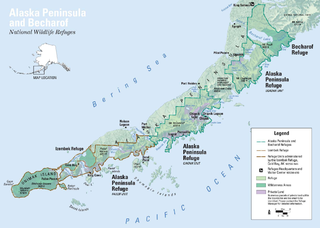
The Alaska Peninsula is a peninsula extending about 497 mi (800 km) to the southwest from the mainland of Alaska and ending in the Aleutian Islands. The peninsula separates the Pacific Ocean from Bristol Bay, an arm of the Bering Sea.
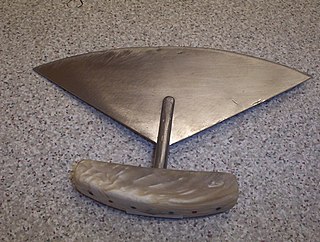
An ulu is an all-purpose knife traditionally used by Inuit, Iñupiat, Yupik, and Aleut women. It is used in applications as diverse as skinning and cleaning animals, cutting a child's hair, cutting food, and sometimes even trimming blocks of snow and ice used to build an igloo.

Semisopochnoi Island or Unyak Island is part of the Rat Islands group in the western Aleutian Islands of Alaska. The island is uninhabited and provides an important nesting area for maritime birds. The island is of volcanic origin, containing several volcanoes including Mount Young. It has a land area of 85.558 square miles, measuring 11 miles (18 km) in length and 12 miles (20 km) in width.

Southwest Alaska is a region of the U.S. state of Alaska. The area is not exactly defined by any governmental administrative region(s); nor does it always have a clear geographic boundary.
The languages of North America reflect not only that continent's indigenous peoples, but the European colonization as well. The most widely spoken languages in North America are English, Spanish, and to a lesser extent French, and especially in the Caribbean, creole languages lexified by them.

Copper Inuit, also known as Inuinnait and Kitlinermiut, are a Canadian Inuit group who live north of the tree line, in what is now the Kitikmeot Region of Nunavut and in the Inuvialuit Settlement Region in the Inuvik Region of the Northwest Territories. Most of them historically lived in the area around Coronation Gulf, on Victoria Island, and southern Banks Island.
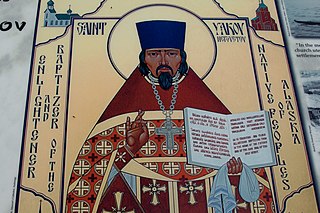
Jacob Netsvetov, Enlightener of Alaska, was an Alaskan Creole from the Aleutian Islands who became a priest of the Orthodox Church and continued the missionary work of Innocent for Alaska Natives. His feast day is celebrated on July 26, the day of his death.
Mednyj Aleut is an extinct mixed language spoken on Bering Island.

The Aleutian Islands —also called the Aleut Islands, Aleutic Islands, or, before 1867, the Catherine Archipelago—are a chain of 14 main, larger volcanic islands and 55 smaller ones. Most of the Aleutian Islands belong to the U.S. state of Alaska, with the archipelago encompassing the Aleutians West Census Area and the Aleutians East Borough. The Commander Islands, located further to the west, belong to the Russian federal subject of Kamchatka Krai, of the Russian Far East. The islands form part of the Aleutian Arc of the Northern Pacific Ocean, and occupy a land area of 6,821 sq mi (17,666 km2) that extends westward roughly 1,200 mi (1,900 km) from the Alaskan Peninsula mainland, in the direction of the Kamchatka Peninsula; the archipelago acts as a border between the Bering Sea to the north and the Pacific Ocean to the south. Crossing longitude 180°, at which point east and west longitude end, the archipelago contains both the westernmost and easternmost parts of the United States, by longitude. The westernmost U.S. island, in real terms, however, is Attu Island, east of which runs the International Date Line.